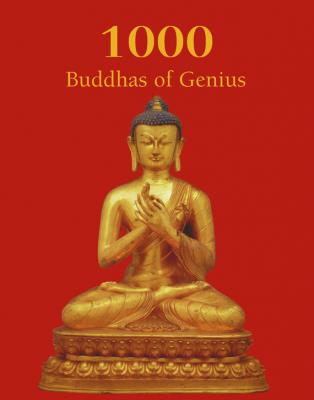1000 Buddhas of Genius. Victoria Charles
Читать онлайн.| Название | 1000 Buddhas of Genius |
|---|---|
| Автор произведения | Victoria Charles |
| Жанр | Энциклопедии |
| Серия | The Book |
| Издательство | Энциклопедии |
| Год выпуска | 0 |
| isbn | 978-1-78310-957-9, 978-1-78310-463-5 |
38. Flower Buddha, date unknown, Tibet, copper with gold, height: 19 cm.
39. Seated Buddha, date unknown, location unknown.
40. Shakyamuni in the bhumisparsha mudra calling the Earth to Witness, date unknown, location unknown.
41. Seated Buddha, date unknown, Sri Lanka, gilt bronze.
42. A richly robed and bejewelled Buddha, date unknown, Xining, Qinghai province, China, moulded from yak butter by Tibetan monks at Ta’er-si monastery.
43. Buddha Statue, date unknown, monastery Kloster Tikse Gompa, near Leh, Ladakh, India.
44. Seated Buddha in the lotus position, date unknown, Bodh Gaya, Bihar state, India.
45. Seated Gautama Buddha displaying the earth-touching mudra, date unknown, Paya Thonzu Temple, Bagan, Burma.
Supreme Awakening (Pali Canon):
Through the round of many births I roamed
without reward,
without rest,
seeking the house-builder.
Painful is birth
again and again.
House-builder, you’re seen!
You will not build a house again.
All your rafters broken,
the ridge pole destroyed,
gone to the Unformed, the mind
has come to the end of craving.
[Dhp 153–4]
Gautama had now arrived at his conclusions regarding the nature of man and the world around him; he had realised the psychological and moral system to which he adhered during his long career. The old system of sacrifice and penance seemed meaningless compared to the apparent simplicity and power of the new one; because of this, Gautama felt more and more intensely the immensity of the distance which separated him from the beliefs of those about him. That feeling of utter loneliness which is often experienced by the leaders of men – especially in moments of high exaltation and insight – broke upon him with such force that it seemed to him impossible to go to his fellow countrymen with a doctrine that to them would seem almost incomprehensible. These men were subject to the same temptations as those whose power he had just experienced, though they lacked the earnestness and insight which he felt himself to possess. How could such men grasp the truth, at once fundamental and deceptively simple, of his system of salvation by self-control and love, without any of the rites, ceremonies, charms, priestly powers, or gods that they had come to trust?
That such a thought occurred to him is very natural, given the circumstances, and this is reflected in the biographies of his life. The reason which they assign as the motive for his final determination is worthy of notice: it is said to have been love and pity for humanity. The thought of mankind, as it seemed to him, utterly doomed and lost, made Gautama resolve, at whatever hazard, to proclaim his doctrine to the world. The pious Buddhist is constantly grateful that Buddha, when he might have been freed from all life’s suffering, was motivated by his love of mankind to live in a world defined by the sorrows of finite existence.
46. Anaradhapura, date unknown, Ruvanvelisaya Dagoba, Sri Lanka.
47. Head of Large Buddha, date unknown, Sukhothai, Thailand.
48. Shweyattaw Buddha, date unknown, Mandalay, Burma.
49. Medicine Buddha, date unknown, location unknown.
50. Standing Buddha, date unknown, Hkinkyiza Kyaung Monastery, Sale, Burma.
The Buddha investigates the laws of cause-and-effect (Pali Canon):
I have heard that on one occasion, when the Blessed One was newly Awakened – staying at Uruvela by the banks of the Nerañjara River in the shade of the Bodhi tree, the tree of Awakening – he sat in the shade of the Bodhi tree for seven days in one session, sensitive to the bliss of release. At the end of seven days, after emerging from that concentration, in the third watch of the night, he gave close attention to dependent co-arising in forward and reverse order, thus:
When this is, that is.
From the arising of this comes the arising of that.
When this isn’t, that isn’t.
From the cessation of this comes the cessation of that.
Now from the remainderless fading and cessation of that very ignorance comes the cessation of fabrications. From the cessation of fabrications comes the cessation of consciousness.
From the cessation of consciousness comes the cessation of name-and-form.
From the cessation of name-and-form comes the cessation of the six sense media.
From the cessation of the six sense media comes the cessation of contact.
From the cessation of contact comes the cessation of feeling.
From the cessation of feeling comes the cessation of craving.
From the cessation of craving comes the cessation of clinging/sustenance.
From the cessation of clinging/sustenance comes the cessation of becoming.
From the cessation of becoming comes the cessation of birth.
From the cessation of birth, then old age and death, sorrow, lamentation, pain, distress, and despair all cease.
Such is the cessation of this entire mass of stress and suffering.
Then, on realising the significance of that, the Blessed One on that occasion exclaimed:
As phenomena grow clear
to the brahmin – ardent, absorbed –
he stands, routing the troops of Mara,
like the sun that illumines
the sky.
[Ud I.3]
51. Reclining Buddha, date unknown, Shwekyimyint Pagoda, Mandalay, Burma.
52. Seated Buddha, date unknown, Nakhon Pathom Chedi, Thailand.
53. Seated Buddha, date unknown, Sagaing, Burma.
54. Buddha statues at Taihu Lake, Wuxi, date unknown, China, clay.
55. Seated Buddhas rest on plinths at the base of a stupa, date unknown, Wat Chai Watthanaram, Bangkok, Thailand, stone.
56. Seated Buddha, date unknown, Shwesayan Pagoda,
